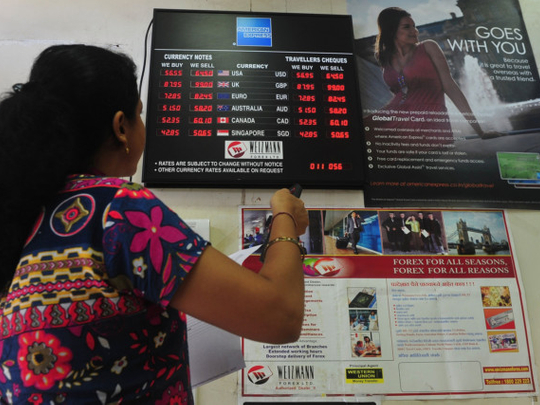
Abu Dhabi: India’s rupee plunged to a new record low on Tuesday, dropping to 61.80 to the US dollar and 16.83 rupees to the UAE dirham before paring some of the losses in late trade as the government announced the appointment of noted economist Raghuram Rajan as the new governor of the Reserve Bank of India (RBI).
Tuesday’s fall erased the INR’s previous all-time low of 61.21 versus the greenback on July 8. The Indian currency has fallen as much as 12.7 per cent since the start of May as the country grapples to bring down its ballooning current account deficit and boost its flagging annual GDP growth rate, factors that have seen foreign institutional investors dumping rupee-denominated assets in favour of the greenback in recent months.
The double whammy of slowing growth and depreciating currency have raised India’s import bill, primarily oil. India meets more than 70 per cent of its crude oil needs from imports, a trade which is dollar-denominated.
Economic experts say that unless Prime Minister Manmohan Singh’s weak coalition government announces substantial reforms or resorts to raising debt abroad to attract rapid capital inflows, the rupee is likely to fall further. The Indian central bank last month announced a slew of measures to support the currency, but the rupee has continued to remain under pressure.
Rajan joined the Indian government last August, after serving as chief economist at the International Monetary Fund (IMF) and a professor at the University of Chicago. Rajan will take the helm of the Indian central bank for a three-year term after Governor Duvvuri Subbarao’s term expires on September 4.
Structural issues
Commenting on the rupee’s record decline, Gaurav Kashyap, head of futures at Alpari ME, a Dubai-based currency brokerage firm, told Gulf News: “When compared to other emerging market currencies and higher yielding assets, the Indian rupee continues to lag behind its counterparts due to deeply rooted domestic structural issues, namely the growing current account deficit and higher inflation levels. Following a weaker-than-expected US non-farm payroll data on Friday, the taper off trade was back on the cards; yet this couldn’t curb any of the bearish sentiment in the INR and the market remains heavily skewed to the sell side.”
He added: “Our upside target of 62.00 against the US dollar remains intact and should hold over the course of the week. Judging by how badly recent RBI measures have failed, we would have to keep an upper limit of 64 in extension over the course of the next two months — particularly if the Federal Open Market Committee looks at a taper when they convene in September. The current employment numbers from the US don’t warrant an early taper and this could stem some of the rupee’s recent losses.”
Kashyap said the appointment of Rajan saw markets close in a buoyant mood.
“However, the sentiment will be short-lived and the RBI will have to turn to further measures — the most likely of which would be to increase the cash reserve ratio requirement. A slew of key US data passed last week, however we could see volatility return towards the end of the week when several Fed members are due to speak, but the INR looks good to hold below 62 through the rest of the week.”












